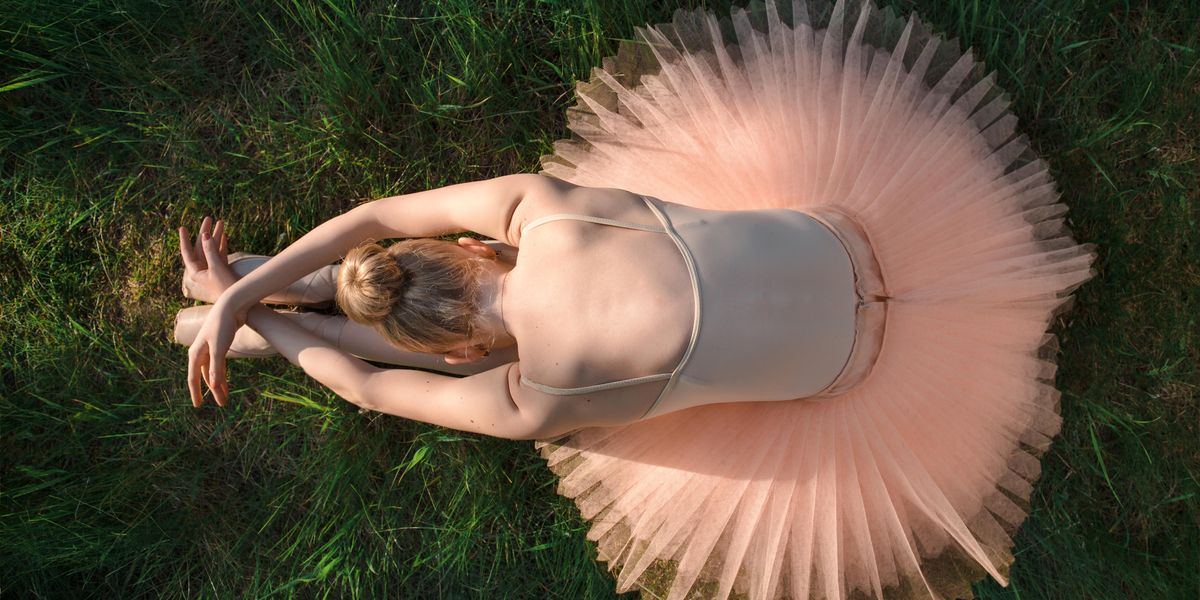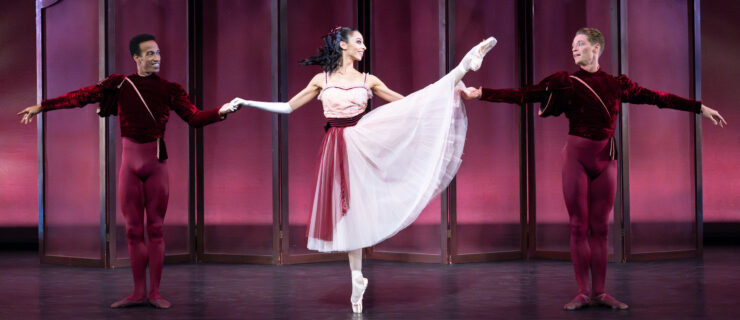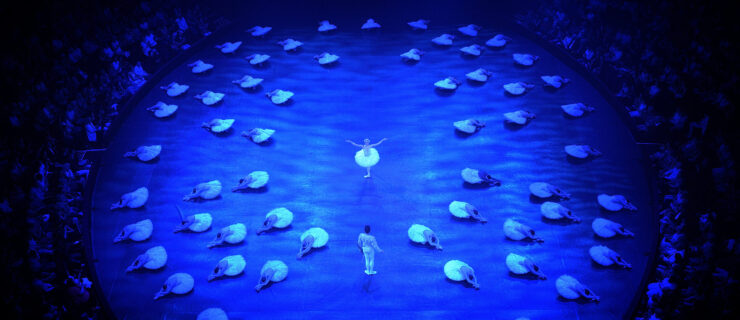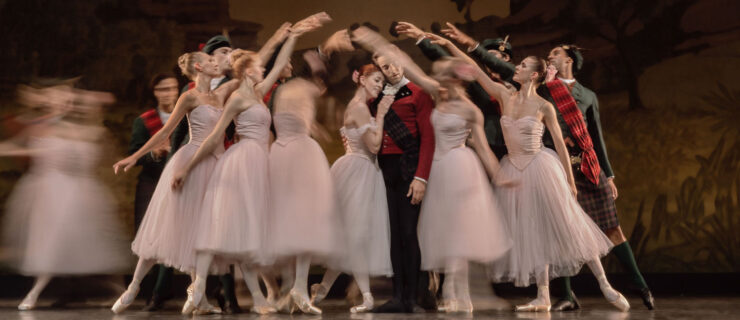The Bewitching Ekaterina Kondaurova
One of the best moments of last April’s Youth America Grand Prix gala at New York’s City Center came in the evening’s second act. Kirov artists Ekaterina Kondaurova and Islom Baimuradov were dancing Alexei Ratmansky’s hypnotic Middle Duet. They’d reached the point where the man and the woman separate and each dance alone in a windowpane of light projected on a dark stage. Then suddenly, Kondaurova leapt out of her space into his with a huge grand jeté unfurled in darkness, collapsing in the light over her partner’s arm.
I’ve seen this leap in Middle Duet done by other dancers many times. But this time it astonished me. It seemed to come from deep inside the ballerina, from the same private place where all the wavelike, hypnotic steps of the dance came. At 5’8”, the 26-year-old second soloist is unusual among a handful of rising Kirov stars. Kondaurova is breathtakingly dramatic, yet she doesn’t “dramatize.” She never signals to the audience that this or that is going to be a showy move. She just does the steps, full out, yet somehow naturally, with all the gorgeous and unabashed physicality of her long body. And her total immersion in the dancing itself has made her not just the queen of the Kirov’s contemporary repertoire, but a radical presence in the classics, as well.
“She’s more spontaneous onstage than most of her colleagues,” says Ratmansky (now American Ballet Theatre’s artist in residence). “So it often looks like she’s improvising, though it’s actually well-rehearsed. She is a modern girl, which is a rarity among Russian dancers—she’s not a princess. And she brings that quality to classical works too, the quality of a contemporary woman, not a fairytale beauty.”
What’s ironic about this ballerina’s story is that she almost didn’t get to dance at all. Born in Moscow, not in St. Petersburg, to an optician father and a mother who stayed home to raise two kids, Kondaurova progressed through gymnastics, piano and little kids’ dance before applying to the Bolshoi Ballet School. But they didn’t take her. At that time the Soviet Union was falling apart, and entrance to the Bolshoi School required a bribe. A Bolshoi teacher told Kondaurova’s mother they should try the ballet academy in the other city—St. Petersburg. The historic Vaganova Academy took the young girl. Her mother moved there with her and stayed until Kondaurova was old enough to live in the dormitory.
“I was never sorry,” Kondaurova says, smiling her enigmatic half-smile, as she folds herself into a chair. Up close her body is striking—lean and long in fitted jeans and a rugby T-shirt, thin yet seemingly alive with sensual power. But the girl herself—with a thick red braid down her back, wide-set hazel eyes and a pointed chin—seems somehow hidden way inside. It’s as if that total availability onstage shrinks to a private place when she’s offstage. She’s not guarded, just quietly poised and polite, smiling that Mona Lisa smile. Or maybe she can hang back because her Middle Duet partner and husband Baimuradov (a principal character dancer at the Kirov) is sitting next to her. Nine years older than Kondaurova, he seems to be watching over her with his keen blue eyes. And making sure, with his fluent English, that her Russian is understood by the interviewer.
“I never wanted to go back—even if I was known at first as ‘that girl from Moscow,’ ” she says in Russian. “There’s this girl and this girl”—she imitates a teacher’s imperious glance—“and over there, ‘that girl from Moscow.’ ”
But the Moscow-outsider status soon disappeared. Kondaurova moved up through the Vaganova Academy, acquired those graceful Kirov head and arms, and in 2001 made it, despite fierce competition from classmates, into the Kirov corps de ballet.
Rising in the Kirov, though (sometimes called the “graveyard of ballerinas”), is even harder than getting in. Kondaurova might have stayed semi-buried in the corps, doing the occasional variation, had the company not made a tour to Frankfurt in late 2003. A man came up to her and praised her performance after she’d danced the slow variation in Paquita. “I didn’t know he was William Forsythe!” she says, as if still surprised. A year later, Forsythe, a known admirer of Amazonian ballerinas, came to St. Petersburg to set three of his works on the Kirov. “And suddenly there I was, in everything,” says Kondaurova. As a near-unknown, she danced the Kirov premiere of Forsythe’s In the Middle Somewhat Elevated—to rave reviews. What followed were starring roles in all the “on the edge” ballets the company has acquired since then, by Forsythe, Ratmansky, Simonov….
Kondaurova still loves those spiky modern roles. “They give you the freedom to be yourself, to open yourself onstage,” she says. What wasn’t so welcome, though, was the stamp they put on her: Contemporary, Not Classical. “For a while, I didn’t get the big classical parts, like Corsaire and Lilac Fairy in Sleeping Beauty,” she says quietly. Luckily, Kondaurova’s coach, Olga Chenchikova, taught her the classical roles in private. Former prima ballerinas themselves, the Kirov coaches teach their protégées roles in one-on-one rehearsals, and also lobby to get them onstage. Chenchikova, herself a tall, imposing former ballerina, helped the young Kondaurova learn how to handle a long body in a pas de deux.
Baimuradov leans forward proudly. “It’s easy to dance with Katya,” he says, using his wife’s nickname, “because Olga taught her to do it all herself.”
“Yes,” Kondaurova breaks in eagerly, as if sharing something she believes in strongly. “You as ballerina have to work too. You have to hold your body, use your legs. Lots of people say ‘Lift me!’ to their partner—then they just do some pretty arms. You can’t give yourself the idea that he does it all.”
This work ethic is slowly erasing any contemporary-roles-only type-casting. “Katya is smart,” says Kirov director Yuri Fateev. She now dances a lot of Balanchine, that part of the repertoire that hovers, in Russian minds, between classical and contemporary. She loves the Balanchine roles: Serenade, Symphony in C, all three parts of Jewels. “But you can’t just step to the side onstage in these ballets like some people do, just executing the steps,” she says firmly. “You can’t dance Balanchine ‘presso,’ dry, ‘without salt and sugar.’ You have to put your personality into the steps.”
Kondaurova has also “seasoned” certain Russian classical variations (in Paquita, La Bayadère) in her own way. When she danced these in the Kirov’s New York City Center season last spring, she was “adopted,” as The New York Observer’s Robert Gottlieb put it, “by New Yorkers in the know.” New York Times critic Alastair Macaulay called Kondaurova “the Kirov’s best dancer.”
“New York,” says Kondaurova, glowing, “gave me confidence.” And then, last fall at home, she got her first Swan Lake, and reportedly gave Odile, the evil black-swan side of the dual role, a boldness of attack that might come easier to a modern girl than the underwater tenderness of Odette. Still, the rest will come. “It’s very nice that the Mariinsky management has started giving her big classical roles,” says Ratmansky, “so that she can develop her already interesting qualities.”
But with all that work, all those new roles—what about free time?
“Free time?” Kondaurova and Baimuradov both roll their eyes in comic unison, meaning there’s never enough of it. “On a free day,” they say almost together, “we don’t go out from home! We do ‘haute couture’ in the kitchen. Very special food, nicely decorated.”
“And we read everything we can get our hands on about home design.” After they married in March 2008—in the morning, before company class!—Baimuradov explains, all they had was one cabinet and a mattress on the floor. Now they’re always adding new accents, collaborating on a home.
“Recently I came home from Taiwan to find all our radiators were gold. She’d painted them!” says Baimuradov. Kondaurova returns his smile, opening out from Mona Lisa to pure glee.
“And we walk,” they both lean forward, excitement in their eyes. “We can walk for hours and hours, around our own neighborhood in St. Petersburg, in Barcelona, in any city we find ourselves.”
“We like new experience,” she says, summing it up for them both. “Some people in the company come to New York, and they go to a Russian restaurant! It’s like choreography,” she adds. “I want to do everything. I would not refuse any role.”
Elizabeth Kendall is a dance writer based in New York, at work on a book about George Balanchine and Lidiia Ivanova.





